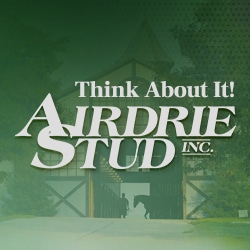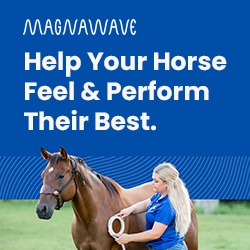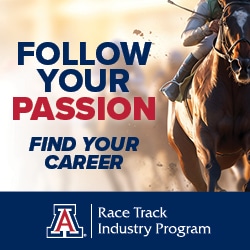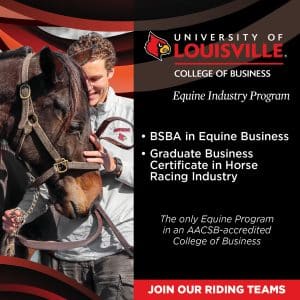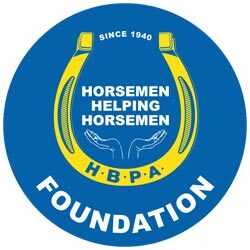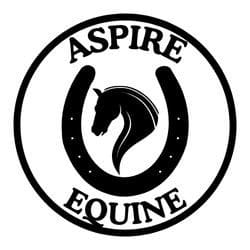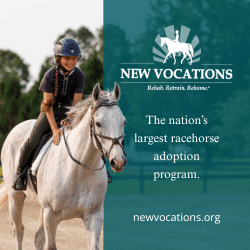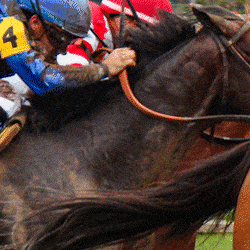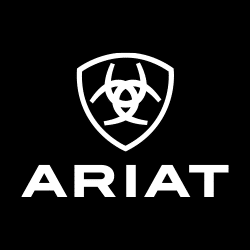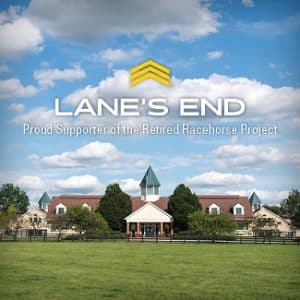Makeover trainers evaluate sport horse potential based on conformation shots
Social media has enabled potential OTTB owners to review a large number of retiring Thoroughbred racehorse listings at any given time. Newcomers to the breed might find it challenging to assess a prospect right off the track and decide if it’s a match for their desired purpose.
That’s why we launched this column, in which past Thoroughbred Makeover trainers share their thoughts about assessing prospects and evaluate example horses based only on their conformation. We feature trainers from two disciplines in each issue.
Brit Vegas
Professional, third place in Field Hunter at the 2019 Thoroughbred Makeover with Bombmarito
Vegas is a professional horsewoman based in Nebraska who specializes in off-track Thoroughbreds at her Royal Fox Stables. She’s a multiple-time Makeover veteran and primarily sells prospects as eventers, jumpers, dressage mounts and field hunters.
Sami Malik
Professional, third place in Competitive Trail at the 2019 Thoroughbred Makeover with Down Town Kitty
Malik is a professional horsewoman based in Georgia who runs the multifaceted operation Blue Skies Riding Academy. She teaches lessons and takes clients to horse shows, while also rehabbing and retraining several OTTBs annually, many of which stay in the lesson program across several disciplines.
Choosing a Horse
Both trainers typically work directly with trainers on the track to find prospects, which allows them to put eyes on how a horse moves at the walk and the trot and discuss a horse’s background. Vegas maintains a key truth in her selection: “It doesn’t matter how fancy a horse looks if it can’t be ridden safely.”
While Malik occasionally takes in a few horses in need, she typically shops for horses for her own program and for clients and adjusts her search based on her needs. “For an amateur or junior, I look for a horse with a soft eye and a quiet jog that either has no injuries or is unraced — in my experience, they tend to be the most ready for a new job,” she says. “For a trail or ranch horse, I want a shorter-coupled back to do the Western maneuvers easier, and in all disciplines I’m looking for good upright (not underrun) feet, a soft slope to the shoulder and short pasterns and cannon bones.”
Malik likes to look for horses at Finger Lakes Racetrack, in New York, where she can meet and speak with trainers directly.
Vegas’ nationwide network of trainers takes her to 15 or 20 racetracks a year. She says the horse’s brain is the most important piece of the puzzle: “I like to discuss how they train on the track and how they like to race; it gives me a good idea of what disciplines they might excel in. I choose horses first by their brain, then their jog and overall soundness and conformation last. It’s a big picture, so I don’t just buy off a photo.”
Vegas knows from experience that some perfectly built horses don’t hold up, while many horses with what look like conformational flaws end up being beautiful movers. “You have to put all the pieces together and decide if that horse will make someone a nice competitive mount,” she says.
Meet the Prospects
Our model horses all come from Akindale Thoroughbred Rescue in Pawling, New York. Founded by horseman John Hettinger, who set aside 300 acres of his Akindale Farm to serve as a refuge for retired racehorses, Akindale is both a sanctuary with permanent residents and a full-scale rehabilitation, retraining and rehoming center. Resident trainers at the Pawling facility, as well as the satellite farm in Salley, South Carolina, start the retraining process to determine where an adoptable horse might excel. Potential adopters must meet a horse before taking it home.
All three horses are available for adoption and eligible for the 2020 Thoroughbred Makeover. While these horses might no longer be available at press time, Akindale has many prospects looking for their next partners.
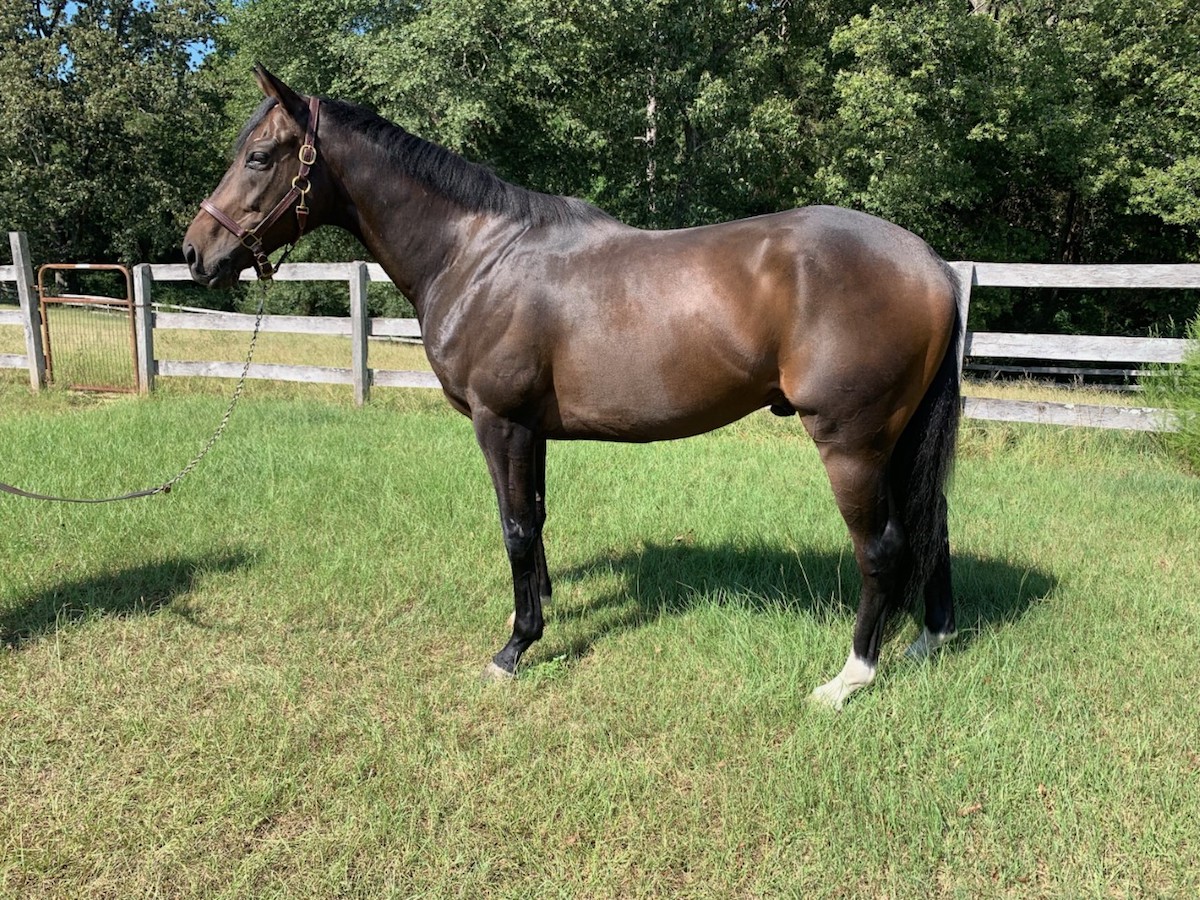
Sofranko (Outflanker — Rock’n With Mary, Deputed Testamony) Courtesy Akindale Thoroughbred Rescue
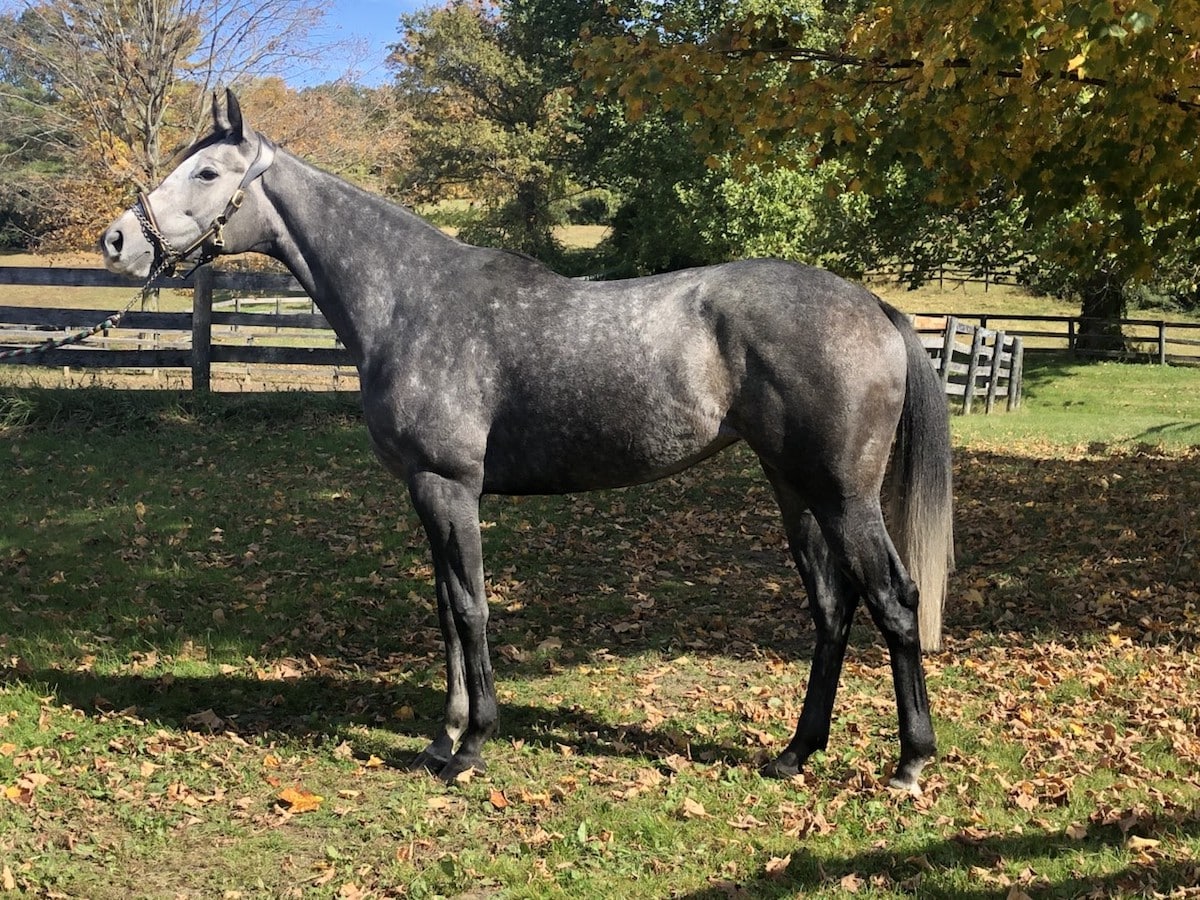
She’s Got Sugar (Cairo Prince — Ravionetta, Touch Gold) Courtesy Akindale Thoroughbred Rescue
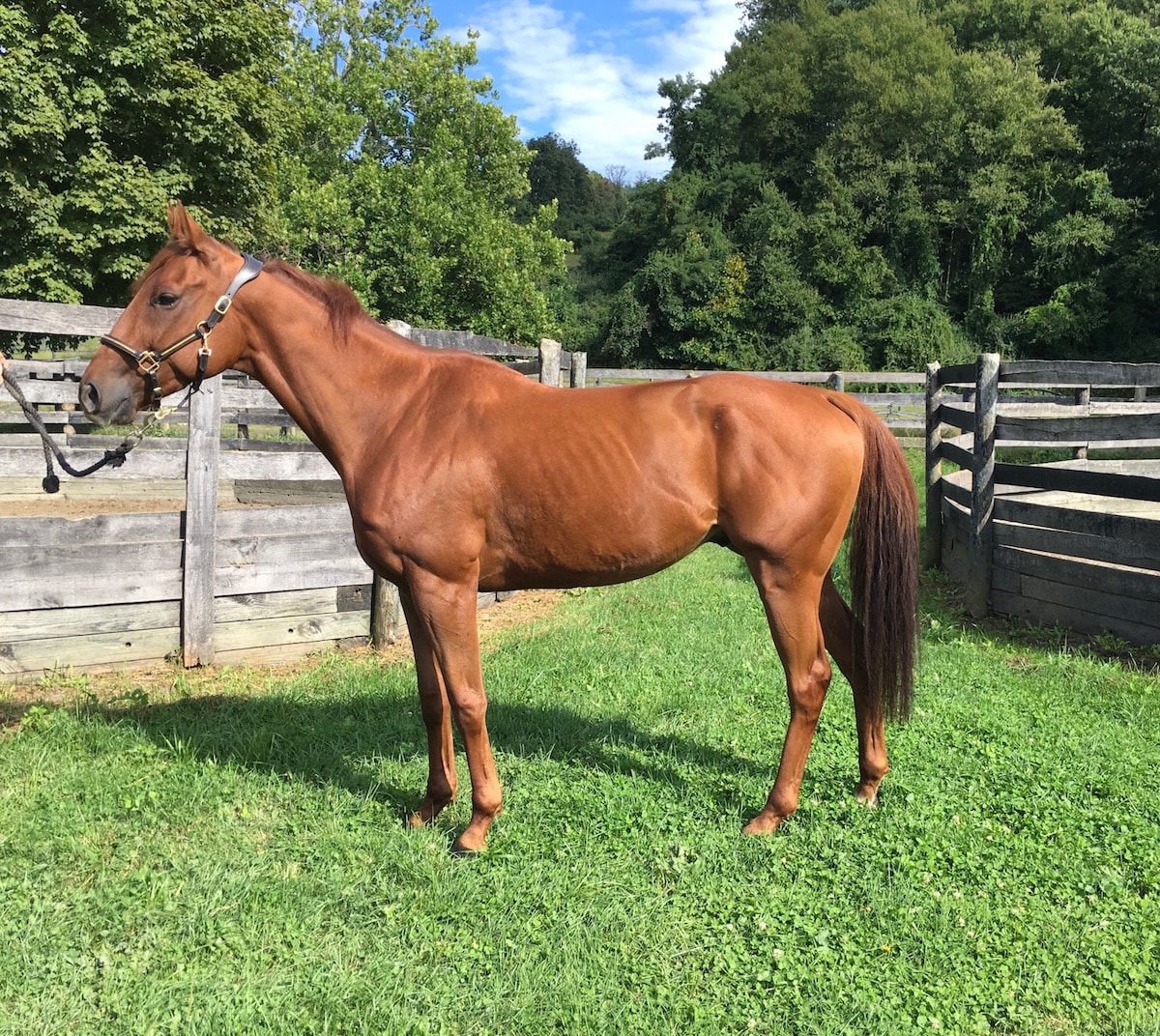
Smart Russian (Smarty Jones — Russian Classic, Regal Classic) Courtesy Akindale Thoroughbred Rescue
Vegas’ Picks
Horse 2 She is a lovely type, with a nice, laid-back shoulder. She is well-balanced through her body. I will note her “hunters bump” in front of her SI. This is not necessarily indicative of an issue but, in my experience, it’s typically more prevalent in a horse that has a hard time holding topline. This horse does not appear to struggle with that. Her uphill build and shoulder would indicate that she would make a nice jumper and be able to bring her knees up well. She has a powerful hip and is overall well-balanced. She does have long cannon bones and is slightly long in her pastern, but she is very likely a lovely mover. In my opinion, this horse looks incredibly athletic and fits the typical look of an eventer.
Horse 1 He is a heavier horse, carrying good muscle. He’s got a nice angle to his shoulder and likely takes a nice step. He has what appear to be nice straight legs, but I do not care for the pastern angles. I would also prefer his neck to be longer, to match his body and better balance him. He is a pretty level-built horse but does carry a shoulder that will help him move with an uphill step. His hind end is powerful and matches the shoulder. He has a kind eye and is an overall nice-looking horse.
Horse 3 He has a much straighter shoulder than the other two horses and pretty upright pasterns. He’s also lacking in weight and muscle. Without knowing his workload or his training, it would be hard to decide if this is because of how he carries himself or if he lacked feed or recent proper training. He has a weaker hip, but I feel this would improve greatly in work. He is a bit long through his back, which makes working a bit more difficult on their bodies. This is likely still a very nice horse and just needs more condition.
Malik’s Picks
Horse 1 The bay has a very kind eye, soft expression and, generally, the overall look that would grab my attention looking for a Western horse. His body is well-proportioned overall, fitting within the rule of thirds as far as his shoulder, barrel and hindquarter being equally proportioned. He is well-muscled and heavier-boned, which is good for the many hours most trail and ranch horses spend under saddle. His shoulder and pastern bones match in angle, showing off good balance from top to bottom. He has nice, short cannon bones and pasterns, which in my experience sets horses up to be less likely to develop arthritis in the future. Overall, he has many great things working in his favor.
Horse 2 The grey has the look of a sport horse I would want to see in a hunter or jumper. I would be more interested in this horse for an English discipline rather than Western. She has a well-balanced body overall. The neck ties in well to the top of the chest, and she has a good topline. This horse has a little bit of a longer back, which generally makes for a more comfortable ride. Considering height and body, this horse is leggier and will generally carry less muscle mass, which is more attuned for a English sport horse prospect than a Western mount. The horse has good upright pasterns, but the front are longer than the rear, which I feel may cause issues with arthritis down the road. Her ankles appear a little thick front and behind, which is something I would want to double-check in person, as photos can be deceiving. Overall, this is a very nice horse that could probably excel in any discipline.
Horse 3 The chestnut screams potential if he had a little more weight and a picture that flatters a bit better — it is hard to give an accurate review of this horse due to how he’s standing. This chestnut is actually very well-put-together, despite the photo. He’s probably the most comfortable ride of the group, based on his overall conformation: nice short pasterns, a relaxed shoulder that isn’t too upright, a longer back and short cannon bones. All of those pieces generally support a good, comfortable ride you want to spend hours in the saddle on. He may or may not toe out on his right front leg, which is something I would want to see in person — I can’t judge from the photo. This horse seems like a kind type that would be solid in any direction for most disciplines. His conformation will allow him to be a jack of all trades.
This article was originally published in the Winter 2020 issue of Off-Track Thoroughbred Magazine, the only publication dedicated to the Thoroughbred ex-racehorse in second careers. Want four information-packed issues a year delivered to your door or your favorite digital device? Subscribe now!

